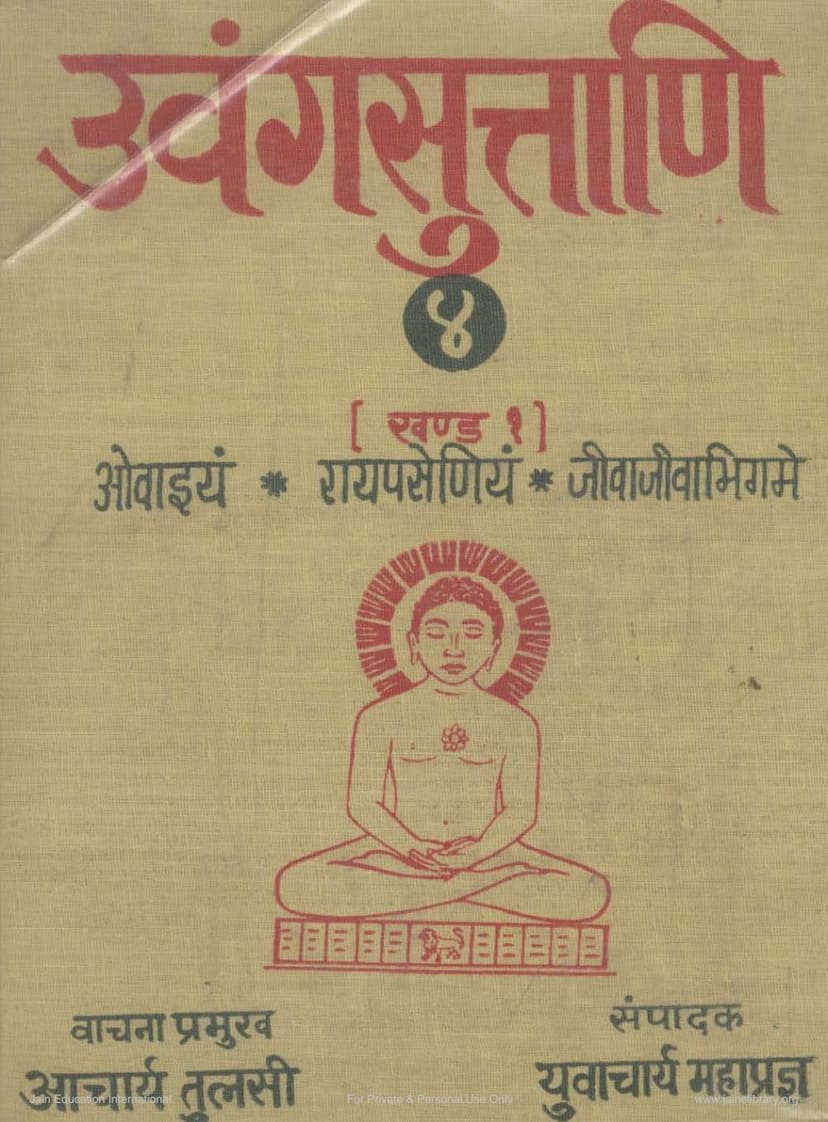Agam 13 Upang 02 Rajprashniya Sutra Raipaseniyam Terapanth
Added to library: September 1, 2025

Summary
Based on the provided text, here's a comprehensive summary of the Jain text, focusing on the Agam 13 Upang 02 Rajprashniya Sutra Raipaseniyam Terapanth:
Title: Agam 13 Upang 02 Rajprashniya Sutra Raipaseniyam Terapanth
Authors: Acharya Tulsi, Acharya Mahapragna
Publisher: Jain Vishva Bharati, Ladnun (Rajasthan)
Overview:
This publication is part of a larger endeavor by Jain Vishva Bharati to critically edit and publish the Jain Agamas. This specific volume, titled "Uvangasuttani, Khand 1," presents the original texts of three Upanga Agamas: Oväiyam (Aupapātika), Rāyapaseṇiyam (Rājapraśnīya), and Jīvājīvābhigame (Jīvājīvābhigama). The text is presented in its original Prakrit script, with critical editing, variant readings, and a combined word index.
Key Themes and Content:
The publication is a result of a significant effort in Agama scholarship, aiming to provide accurate and well-researched editions of these foundational Jain scriptures. The editorial process involved extensive collaboration and consultation of various manuscripts.
1. Oväiyam (Aupapātika):
- Nomenclature: The name "Oväiyam" derives from its central theme, "upapāta" (instantaneous rebirth). Its Sanskrit form is "Aupapātika."
- Subject Matter: The primary focus is on rebirth, explaining how certain actions lead to specific future rebirths. It also includes various descriptive passages (varnakas) of cities, palaces, gardens, kings, etc., which are frequently referenced in other Agamas.
- Commentaries: The text is accompanied by commentaries, notably the "Vṛtti" by Abhayadeva Sūri, considered the first commentary. The editorial process highlights the abundance of variant readings (vacanāntara) in this scripture, which the commentary meticulously addresses.
2. Rāyapaseṇiyam (Rājapraśnīya):
- Nomenclature: The name stems from the dialogues between King Pradeśī and Keśi Swāmī, who answered the king's questions about fundamental principles of Jainism. The text emphasizes the importance of these royal questions and discussions.
- Subject Matter: The core of this Agama is the discourse on profound philosophical and ethical topics, presented through dialogues between King Pradeśī and the Jaina monk Keśi Swāmī. The editorial notes discuss the etymology and potential linguistic variations of the name.
- Commentaries: The publication includes the Sanskrit "Vṛtti" by the renowned commentator Ācārya Malayagiri and a "Stabaka" (a shorter commentary/translation) likely by Dharmasī Muni. The complexities of textual variations were a significant challenge for the commentators.
3. Jīvājīvābhigame (Jīvājīvābhigama):
- Nomenclature: The name signifies its central theme: the exposition of the two fundamental realities in Jainism – Jiva (sentient beings) and Ajiva (non-sentient beings).
- Subject Matter: The Agama is structured into nine chapters, each detailing the numerical classifications of sentient beings from different perspectives. It explores various categories of souls based on the number of senses, elemental classifications, states of existence (like hellish beings, animals, humans, and celestial beings), and temporal classifications (like first-moment and subsequent-moment beings). The text also touches upon broader philosophical concepts like the nature of the soul and the cycle of birth and death.
- Aesthetic and Societal Insights: Beyond doctrinal content, the text offers insights into the social life, architecture, and customs of ancient India, as described in its detailed narratives. The descriptions of things like the "Nanda Pushkarini" and "Chaitra Stambha" provide glimpses into the aesthetic and cultural milieu.
- Commentaries: Two main commentaries are available: one by Ācārya Haribhadra (concise) and the other by Ācārya Malayagiri (extensive). Malayagiri's commentary frequently refers to earlier Jain texts like the "Mūla Tīkā" and "Cūrṇi," indicating a rich lineage of scriptural interpretation.
Editorial Approach:
The publication emphasizes a critical and research-oriented approach to editing the Agamas. This includes:
- Critical Editing: The texts are critically edited, aiming for accuracy based on a thorough examination of manuscripts.
- Variant Readings: The text incorporates discussions and presentations of variant readings found in different manuscript traditions, acknowledging the historical challenge of textual transmission.
- Linguistic Analysis: The importance of grammatical and Ārṣa (ancient Jain usage) specific vocabulary is recognized, and variant words are distinguished from textual variations.
- Scholarly Collaboration: The publication is a collaborative effort, with significant contributions from scholars like Muni Sudarshan, Muni Madhukar, Muni Hiralal, Muni Shrichand, and Sadhvi Siddhaprajña, along with guidance from Acharya Tulsi and the editorial work of Yuvacharya Mahaprajna.
Context of Publication:
This publication is presented as a contribution during the "Acharya Tulsi Amrit Mahotsava Year," highlighting its significance in promoting Jain knowledge and tradition. The publisher, Jain Vishva Bharati, plays a crucial role in disseminating these ancient scriptures to a wider audience.
Overall Significance:
This volume represents a vital contribution to Jain Agam literature, providing scholars and practitioners with a critical edition of three important Upanga texts. The meticulous editorial work, attention to textual variations, and the detailed information on each text's background, subject matter, and commentaries make it a valuable resource for understanding the depth and richness of Jain scriptures.